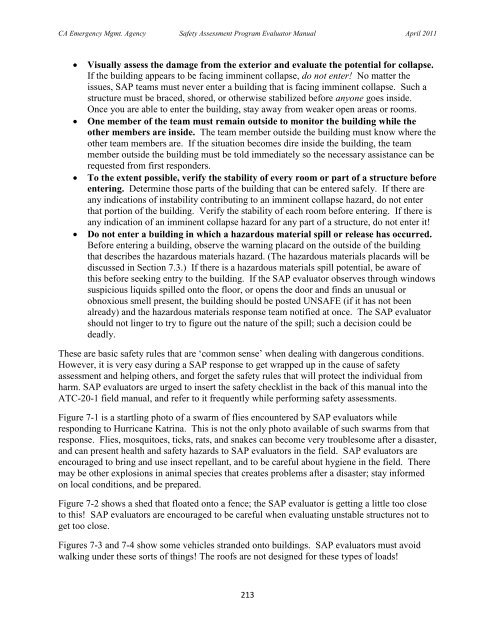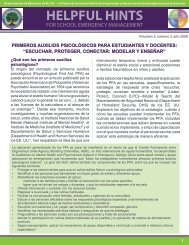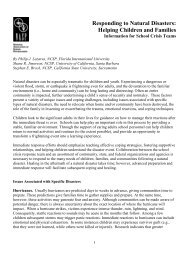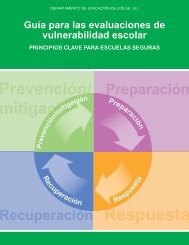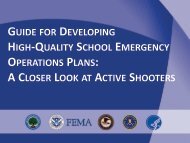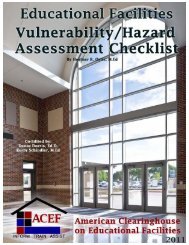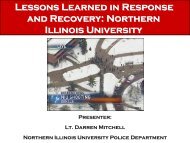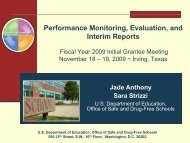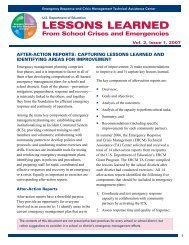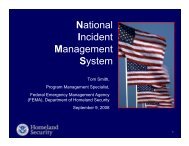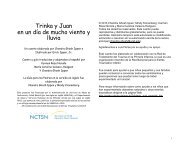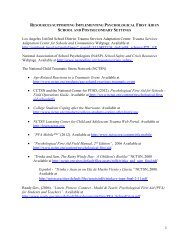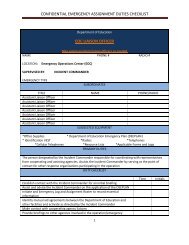Safety Assessment Program Evaluator Student Manual
Safety Assessment Program Evaluator Student Manual
Safety Assessment Program Evaluator Student Manual
Create successful ePaper yourself
Turn your PDF publications into a flip-book with our unique Google optimized e-Paper software.
CA Emergency Mgmt. Agency <strong>Safety</strong> <strong>Assessment</strong> <strong>Program</strong> <strong>Evaluator</strong> <strong>Manual</strong> April 2011Visually assess the damage from the exterior and evaluate the potential for collapse.If the building appears to be facing imminent collapse, do not enter! No matter theissues, SAP teams must never enter a building that is facing imminent collapse. Such astructure must be braced, shored, or otherwise stabilized before anyone goes inside.Once you are able to enter the building, stay away from weaker open areas or rooms.One member of the team must remain outside to monitor the building while theother members are inside. The team member outside the building must know where theother team members are. If the situation becomes dire inside the building, the teammember outside the building must be told immediately so the necessary assistance can berequested from first responders.To the extent possible, verify the stability of every room or part of a structure beforeentering. Determine those parts of the building that can be entered safely. If there areany indications of instability contributing to an imminent collapse hazard, do not enterthat portion of the building. Verify the stability of each room before entering. If there isany indication of an imminent collapse hazard for any part of a structure, do not enter it!Do not enter a building in which a hazardous material spill or release has occurred.Before entering a building, observe the warning placard on the outside of the buildingthat describes the hazardous materials hazard. (The hazardous materials placards will bediscussed in Section 7.3.) If there is a hazardous materials spill potential, be aware ofthis before seeking entry to the building. If the SAP evaluator observes through windowssuspicious liquids spilled onto the floor, or opens the door and finds an unusual orobnoxious smell present, the building should be posted UNSAFE (if it has not beenalready) and the hazardous materials response team notified at once. The SAP evaluatorshould not linger to try to figure out the nature of the spill; such a decision could bedeadly.These are basic safety rules that are „common sense‟ when dealing with dangerous conditions.However, it is very easy during a SAP response to get wrapped up in the cause of safetyassessment and helping others, and forget the safety rules that will protect the individual fromharm. SAP evaluators are urged to insert the safety checklist in the back of this manual into theATC-20-1 field manual, and refer to it frequently while performing safety assessments.Figure 7-1 is a startling photo of a swarm of flies encountered by SAP evaluators whileresponding to Hurricane Katrina. This is not the only photo available of such swarms from thatresponse. Flies, mosquitoes, ticks, rats, and snakes can become very troublesome after a disaster,and can present health and safety hazards to SAP evaluators in the field. SAP evaluators areencouraged to bring and use insect repellant, and to be careful about hygiene in the field. Theremay be other explosions in animal species that creates problems after a disaster; stay informedon local conditions, and be prepared.Figure 7-2 shows a shed that floated onto a fence; the SAP evaluator is getting a little too closeto this! SAP evaluators are encouraged to be careful when evaluating unstable structures not toget too close.Figures 7-3 and 7-4 show some vehicles stranded onto buildings. SAP evaluators must avoidwalking under these sorts of things! The roofs are not designed for these types of loads!213


